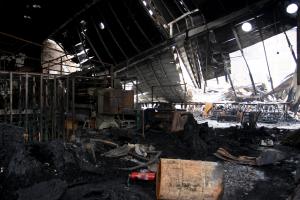Why Fire Damage Requires Specialized Expertise
Effective restoration demands a deep understanding of building materials, safety protocols, and specialized techniques to restore properties to their pre-damage condition”
NEW ORLEANS, LA, UNITED STATES, December 13, 2024 /EINPresswire.com/ -- Fire damage is one of the most devastating events that can affect a property. Beyond the visible destruction caused by flames, fire incidents often leave behind smoke damage, soot, structural instability, and compromised air quality. Addressing these challenges requires specialized expertise to ensure thorough restoration and long-term safety.— Earl Carr, Jr.
Earl Carr, Jr., president of Gulf 52, emphasizes the importance of professional intervention in fire damage restoration. "Fire damage is complex and multifaceted. Effective restoration demands a deep understanding of building materials, safety protocols, and specialized techniques to restore properties to their pre-damage condition."
The Complex Nature of Fire Damage
Fire damage goes beyond what is immediately visible. Flames can weaken structural components, making a building unsafe to occupy. Smoke and soot can infiltrate walls, ceilings, and HVAC systems, leading to long-term issues if not properly addressed. Additionally, the water used to extinguish the fire often causes secondary damage, including mold growth and material degradation.
Key aspects of fire damage include:
Structural Integrity: Fire weakens building materials, including wood, concrete, and steel. Restoration experts must assess the extent of damage to determine which components can be salvaged and which must be replaced.
Smoke and Soot Damage: Smoke particles penetrate porous materials, leaving behind stains, odors, and toxic residues. Soot, a byproduct of incomplete combustion, can cause discoloration and corrosion if not removed promptly.
Water and Mold Damage: Water used in firefighting efforts can saturate materials, leading to warping, swelling, and mold growth. Addressing water damage is a critical component of fire restoration.
Specialized Techniques and Equipment
Fire damage restoration involves a combination of cleaning, repairing, and replacing affected materials. Professionals use advanced techniques and equipment to ensure thorough restoration:
Structural Assessments: Engineers and restoration experts evaluate the safety and stability of the property, identifying compromised areas that require immediate attention.
Smoke and Odor Removal: Industrial-grade air scrubbers, thermal foggers, and ozone machines are used to remove lingering smoke odors and airborne contaminants.
Soot Removal: Specialized cleaning agents and methods, such as dry ice blasting and chemical sponges, effectively remove soot from various surfaces.
Water Extraction and Drying: High-capacity dehumidifiers, air movers, and moisture meters ensure that water damage is mitigated and materials are thoroughly dried.
Material Replacement: Damaged drywall, flooring, and insulation are replaced to restore the property to its original condition.
Health and Safety Risks
Fire damage restoration must address potential health and safety risks associated with post-fire conditions. These risks include:
Toxic Residues: Smoke contains hazardous chemicals that can linger on surfaces and in the air. Proper cleaning and ventilation are essential to remove these toxins.
Compromised Air Quality: Soot and smoke particles can exacerbate respiratory conditions and pose long-term health risks if not removed.
Unstable Structures: Weakened walls, ceilings, and floors present safety hazards that require immediate stabilization or replacement.
Professionals follow strict safety protocols to minimize these risks, ensuring that properties are safe for reoccupation.
The Importance of Compliance
Fire damage restoration must adhere to local building codes, safety regulations, and industry standards. Improper restoration can lead to compliance issues, liability concerns, and reduced property value. Professionals are equipped with the knowledge and certifications required to meet these standards, providing assurance that the restoration process is thorough and compliant.
Preventing Secondary Damage
Delaying fire damage restoration can lead to secondary issues that compound the original damage. Soot and smoke residues become harder to remove over time, while untreated water damage promotes mold growth and material decay. Immediate intervention is essential to minimize these risks and reduce overall restoration costs.
Carr highlights the importance of timely action. "Addressing fire damage promptly prevents further deterioration and ensures a more efficient restoration process."
The Role of Professional Expertise
Fire damage restoration is not a task for untrained individuals. It requires specialized knowledge, tools, and experience to address the unique challenges posed by fire, smoke, and water damage. Professionals bring value through:
Comprehensive Assessments: Identifying all areas affected by fire and secondary damage.
Tailored Solutions: Developing restoration plans that address the specific needs of the property.
Advanced Equipment: Using state-of-the-art tools and techniques for effective cleaning and repair.
Regulatory Compliance: Ensuring all work meets safety and building standards.
Supporting Property Owners After a Fire
Fire damage restoration goes beyond physical repairs. Professionals provide guidance and support throughout the process, from coordinating with insurance providers to helping property owners navigate the complexities of rebuilding. This comprehensive approach ensures that properties are restored efficiently and safely.
Conclusion
Fire damage restoration is a complex process that demands specialized expertise to address the full scope of damage. From structural assessments to soot removal and water mitigation, professional intervention ensures thorough and compliant restoration.
Morgan Thomas
Rhino Digital, LLC
+1 504-875-5036
email us here
Visit us on social media:
Facebook
Legal Disclaimer:
EIN Presswire provides this news content "as is" without warranty of any kind. We do not accept any responsibility or liability for the accuracy, content, images, videos, licenses, completeness, legality, or reliability of the information contained in this article. If you have any complaints or copyright issues related to this article, kindly contact the author above.


